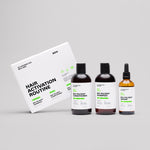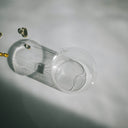Testosterone replacement therapy or testosterone injection is a ray of hope for individuals suffering from hypogonadism and associated disorders. Adequate testosterone production is essential for the body's sexual and physiologic functions. Low testosterone level may manifest as anemia, depressive behavior, sexual dysfunction, reduced sexual desire, and reduced bone and muscle mass.
This article shed light on the does TRT cause hair loss and how these patients can experience average hair regrowth. If so, then how to avoid hair loss on TRT treatment?
Table of content
What is TRT or Testosterone Replacement Therapy?

Testosterone replacement therapy is a hormone replacement therapy used to manage male hypogonadism and associated disorders. The primary goal of this testosterone therapy is to restore the function of male gonads and testes and aid in the normal functioning of the hypothalamic-pituitary-gonadal axis.
The signs and symptoms of male hypogonadism and low testosterone levels include erectile dysfunction, loss of libido, mood disturbances, anemia, and significant muscle and bone mass reduction. This testosterone treatment is the mainstay treatment for congenital hypogonadism in males. However, this hormone therapy can also treat and manage acquired conditions.
Natural testosterone is the first choice of testosterone preparations for this therapy. Natural testosterone is converted to estradiol via aromatase and dihydrotestosterone via 5-alpha reductase in the human body.
Testosterone preparations in testosterone therapy may be delivered via different routes. These include oral, buccal, intranasal, subcutaneous, topical, and intramuscular administration of different forms of male sex hormone testosterone.
As your leading source for hair health information over the past 4 years, we never compromise on accuracy. When it comes to your health, you deserve information you can truly rely on - and earning your trust is our top priority.
Here's how Scandinavian Biolabs ensures every piece of content meets the highest standards of accuracy and integrity:
- Credentialed Experts: Our reviewers are actively practicing doctors and medical researchers
- Stringent Reviews: Content undergoes rigorous editing by subject specialists and review by a practicing doctor.
- Evidence-Based: We rely on well-established research from trusted scientific sources like peer-reviewed journals and health authorities.
- Full Transparency: Our editorial standards, writer credentials, reviewer credentials, correction process, and funding are all publicly documented.
- Independent Voice: While we do promote products, we operate in a vacuum to business operations. Our main goal is just an unwavering commitment to providing medically-sound guidance.
You can count on Scandinavian Biolabs to consistently deliver the trustworthy health information you deserve. Read our Editorial Standards.
When do you need testosterone injections?

The signs and symptoms of low testosterone levels (low t) and male hypogonadism signify the need for testosterone therapy. These signs and symptoms are already mentioned in the general discussion. The clinical evaluation and diagnosis of low t are made based on reduced t level in the blood and the presence of associated clinical features.
Androgen deficiency is assessed by evaluating total testosterone concentrations, bioavailable testosterone, free testosterone, and free androgen index. The most accurate diagnostic test in the measurement of bioavailable testosterone; however, this test is not widely applicable. Morning total testosterone is the most commonly used diagnostic test for testosterone deficiency.
What are the benefits of TRT?
Testosterone replacement therapy results in the improvement of the symptom of testosterone deficiency. This includes:
- Improved low libido and sperm production
- Lessened erectile dysfunction
- Attuned anemia
- Regulated mood disorders
- Increased bone mineral density
- Gained lean body mass and reduced body fat
- Increased muscle mass
- Boosted muscle and bone strength
- Modulated depressive symptoms
- Improved cognitive skills.
- Enhanced hair growth and hair density
Subcutaneous administration of testosterone preparation improves scalp hair growth owing to the anabolic effect of testosterone. Testosterone replacement therapy has proven beneficial for treating and managing female and male pattern hair loss.
The interval between the initiation of testosterone replacement therapy (TRT) and the emergence of noticeable outcomes ranges from 3 months to 2 years.
What are the potential side effects of TRT?
Testosterone therapy is contraindicated in individuals at a higher risk of suffering from breast cancer or prostate cancer. It is also contraindicated in adults with higher hematocrit levels or severe chronic heart failure, lower urinary tract symptoms, and obstructive sleep apnea. Testosterone replacement therapy shall also be avoided by those men who desire to have children within 6-12 months.
After initiation of testosterone injections, specific markers shall be monitored regularly to ensure that the treatment is safe and effective. These markers include serum testosterone concentration, hematocrit, prostate-specific antigen (PSA), and bone mineral density.
Following are the significant adverse effects of testosterone therapy:
- It may hinder normal spermatogenesis and may result in Oligospermia. This is rather challenging for individuals trying to impregnate an ovum.
- It may also be associated with the onset of adverse cardiovascular events, particularly in individuals with a high body mass index (BMI).
- Prostate safety is a significant concern in individuals receiving testosterone replacement therapy. It is associated with an elevated prostate-specific antigen in blood and an increased risk of prostate cancer in these individuals. Prostate pathologies may also lead to the onset of lower urinary tract symptoms.
Does TRT cause hair loss?

In short, this does not prove that testosterone replacement therapy is the primary culprit of hair loss.
Genetic factors and other environmental determinants play a crucial role in the onset of baldness, along with the increased conversion of testosterone to higher DHT level. In androgen-deficient women, subcutaneous testosterone therapy tends to improve hair growth due to testosterone's anabolic effects.
Androgens play a crucial role in the development and severity of hair loss disorders. Androgens are primarily associated with hair loss, androgenetic alopecia, or male pattern baldness characterized by increased sensitivity of hair follicles to androgens in the body.
5-alpha reductase is an enzyme located in the hair follicles. This enzyme catalyzes the conversion of testosterone to dihydrotestosterone (DHT), a relatively more potent androgen.
DHT disrupts the normal hair growth cycle and suppresses the proliferation of follicular hair cells. This causes the hair to grow thinner and weaker, eventually falling off the scalp leading to excessive hair loss.

Individuals who are genetically susceptible to hair loss disorders such as androgenetic alopecia are more likely to suffer from hair loss during testosterone replacement therapy than those who are not genetically susceptible to hair loss disorders.
Genetic predisposition causes the hair follicles to demonstrate an exaggerated response in the presence of androgens and have higher catalytic activity of 5-alpha reductase.
Testosterone replacement therapy elicits hair loss in genetically susceptible individuals due to increased concentration and testosterone hormone levels. As previously discussed, this testosterone is converted to a more potent form, DHT.
However, some individuals may be genetically resistant to the detrimental effects of testosterone and DHT on the hair follicle; hence, they do not suffer from hair loss during testosterone replacement therapy.
The hair loss during testosterone replacement therapy is directly proportional to the concentration of androgens the person receives. Increased exposure to exogenous testosterone for a relatively longer duration leads to proportional hair loss in genetically susceptible individuals.
People already suffering from male pattern baldness tend to observe worsening of the symptoms upon receiving testosterone replacement therapy.
Is there scientific evidence that TRT causes hair loss?

External testosterone is administered to the patient during Testosterone Replacement Therapy (TRT). As a consequence, many individuals think that increasing testosterone levels may promote increased DHT within the body, resulting in hair loss and baldness.
The fact that testosterone has a byproduct further suggests that TRT might have a negative impact on hair loss. Because medication raises the body's testosterone levels, it may create DHT, which disturbs the natural inclination of hair follicles on the scalp. As a result, some persons may notice a decline in hair growth at the start of therapy.
However, none of these assumptions have been validated by reliable scientific study. Numerous studies and investigations have been conducted on this subject, however the outcomes always show inconsistent results of Testosterone Replacement Therapy owing to age and hereditary variables. Finally, it all comes down to individual genetic variances, which may result in hair loss induced by TRT in some men while others exhibit a symptomatic favorable response.
How to combat testosterone injection hair thinning?
Not all individuals undergoing testosterone replacement therapy suffer from hair loss. Those individuals who experience hair loss during testosterone replacement therapy tend to synthesize excessive DHT from the administered testosterone.
Therefore, treatment options for testosterone replacement therapy-associated hair loss shall target the underlying mechanisms of increased synthesis and detrimental effects of DHT.
Following therapeutic modalities can improve hair loss and stimulate hair growth in individuals who suffer from hair loss while receiving testosterone replacement therapy.
Scandinavian Biolabs Hair Growth Routine

If you're looking for a guaranteed hair growth solution that is vegan, naturally-derived and most importantly, works, then our Hair Growth Routine is for you.
Finasteride
Oral finasteride is approved by the US Food and Drug Administration for treating benign prostatic hyperplasia and androgenetic alopecia. Finasteride treats androgenetic alopecia or male pattern baldness at an approved dosage concentration of 1 mg. The anti-androgen properties of finasteride make this medication beneficial for alleviating signs and symptoms of hyperandrogenism.
Finasteride works by suppressing the catalytic activity of types II and III 5-alpha reductase, reducing testosterone conversion to DHT. Reduced levels of DHT in both serum and hair follicles have a beneficial effect on hair physiology. Individuals suffering from androgenetic alopecia report improved body hair growth within 12 months of finasteride therapy.
Minoxidil

The topical application of minoxidil foam or solution also improves hair growth. This FDA-approved pharmacologic formulation was initially developed as a vasodilator agent to combat cardiovascular pathologies. Later on, minoxidil was approved for use to treat androgenetic alopecia.
Although not approved, minoxidil is also used to treat alopecia areata, chemotherapy-induced alopecia, telogen effluvium after hair transplantation, scarring alopecia, and hereditary alopecia.
Minoxidil is a potent hair growth stimulator. Minoxidil demonstrates beneficial effects after conversion into its active metabolite called minoxidil sulfate. This conversion is catalyzed by the enzyme sulfotransferase. Different individuals have different activities of sulfotransferase. Therefore, minoxidil efficacy varies from person to person.
Minoxidil works by shortening the telogen phase and increasing the duration of the anagen phase of the human hair growth cycle. Moreover, minoxidil stimulates the potassium channels, leading to arteriolar vasodilation, increased vascularization, and protection of the androgen-sensitive hair follicles from the growth-inhibiting effects of androgens.
Stinging Nettle
Herbal extracts are also beneficial for stimulating hair growth via minimal adverse effects compared to pharmacologic formulations. Stinging nettle or Urtica dioica is beneficial for stimulating hair growth and combating hair loss.
Application of stinging nettle root extract or tea consumption suppresses the release of inflammatory cytokines and cures non-scarring alopecia, including androgenetic alopecia and alopecia areata, and telogen effluvium.
Saw Palmetto

Saw palmetto is a herbal extract obtained from berries of palm trees called Serenoa repens. Saw palmetto is a natural 5-alpha reductase inhibitor commonly used to treat androgenetic alopecia. Owing to a minimum and fewer adverse side effects, saw palmetto is considered a relatively safe alternative to finasteride.
Saw palmetto works by suppressing the catalytic activity of 5-alpha reductase, hinders binding of DHT with the androgen receptor of hair follicles, and reduces the uptake of DHT by the hair follicles.
Azelaic Acid
A substance that occurs naturally in whole grains and has a mild antibiotic that kills harmful bacteria on the skin. Additionally, it has the capacity to inhibit the 5-alpha reductase found in human skin. A decrease in the level of DHT in the body has a comparable impact to finasteride, the key element in the FDA-approved oral hair loss treatment Propecia.
GHK-Cu Foam
This medication's GHK-Copper foam detects the presence of naturally occurring copper. This drug is a copper complex that controls several functions in the human body, such as hair follicle stimulation and blood vessel growth encouragement. The concentration of GHK-Cu impacts the result of any hair loss treatment or therapy. This medicine is used to prevent hair loss and to stimulate hair follicles to grow longer, thicker, and stronger hair.
Hair Transplant
A hair transplant is a safe and effective hair restoration treatment of androgenic alopecia, particularly in those individuals who do not derive benefit from pharmacologic treatments. The two techniques involved in hair transplantation include follicle unit transplantation (FUT) and follicle unit extraction (FUE). Post-treatment complications are rare and less severe.
Read more:
- How To Stop Hair Loss And Regrow Hair Naturally? - A Story
- 8 Tested Ways How To Regrow Hair Naturally For Black Men?
- 11 Best Methods How To Strengthen Hair Naturally At Home?
References
- https://www.ncbi.nlm.nih.gov/labs/pmc/articles/PMC5583373/
- https://onlinelibrary.wiley.com/doi/10.1111/andr.12774
- https://www.ncbi.nlm.nih.gov/labs/pmc/articles/PMC6462962/






